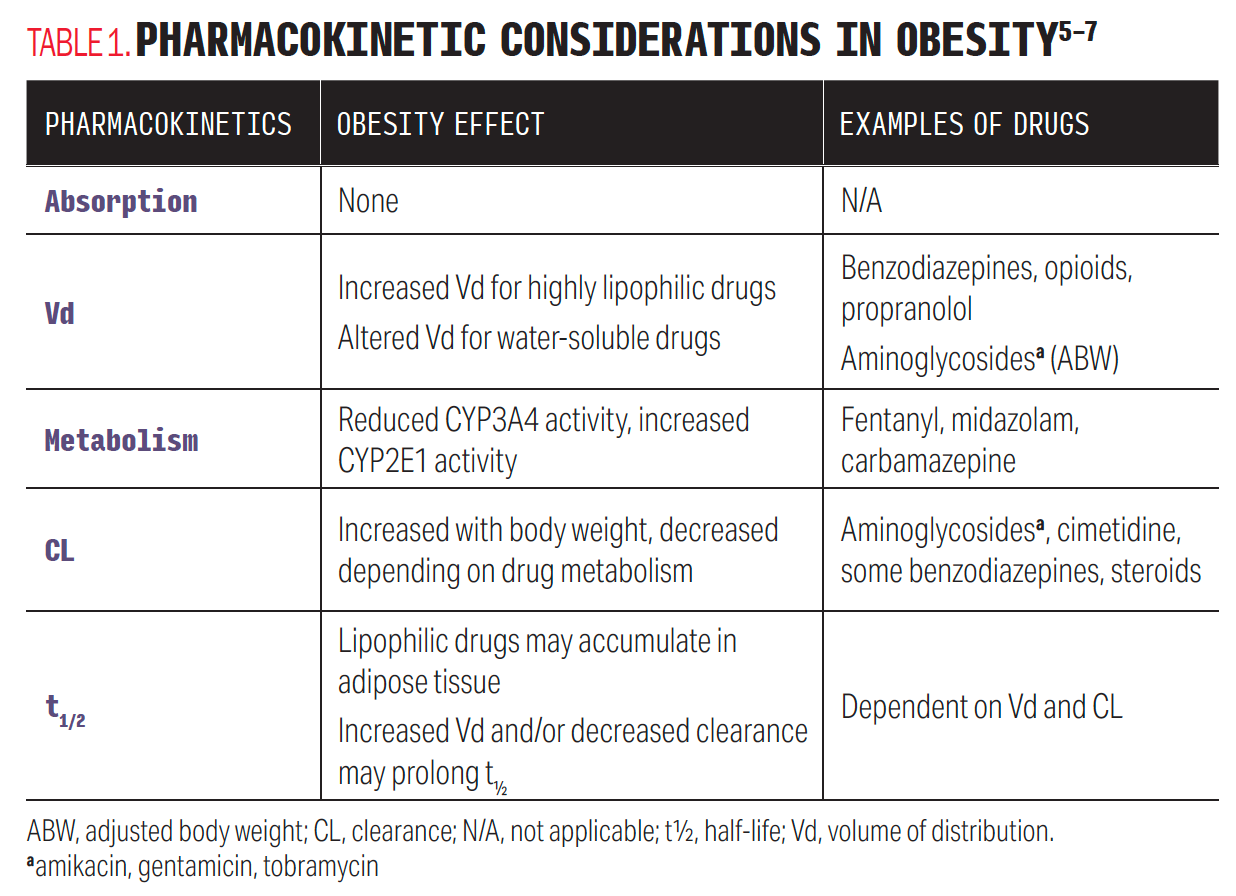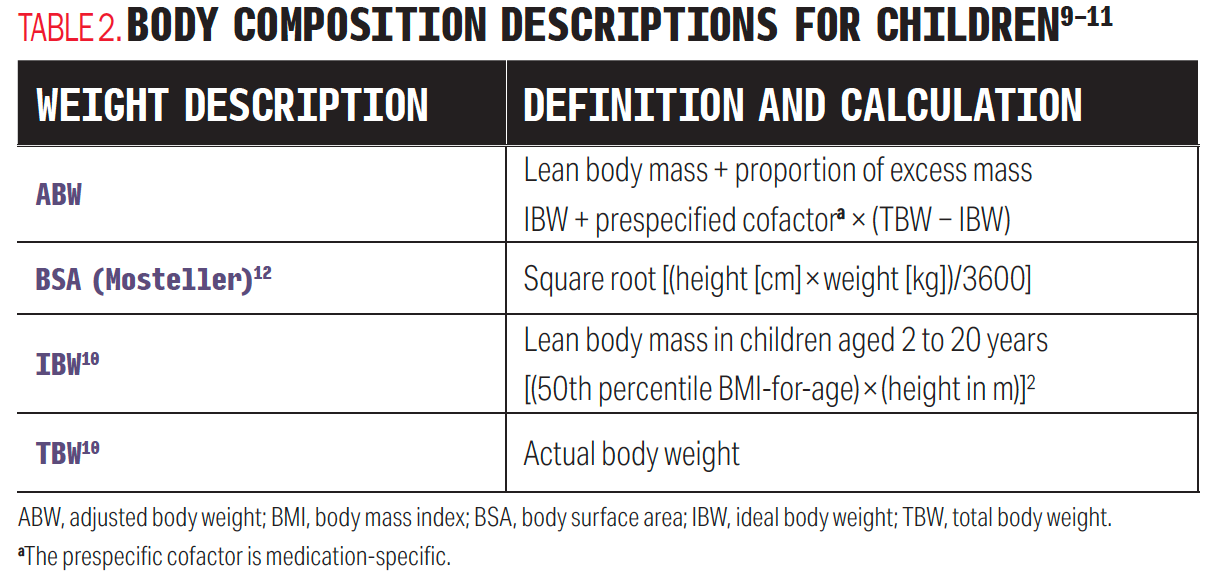Medication Dosing in Pediatric Obesity Presents Complexities and Challenges
Careful thought and adjustments are required to avoid exceeding the maximum recommended amount.
Obesity in children and adolescents is a growing global public health concern. Recent data indicate that upward of 18.5% of children and adolescents in the United States have obesity.1,2 The CDC and the American Academy of Pediatrics (AAP) define obesity in individuals aged 2 to 20 years as a body mass index (BMI) equal to or above the 95th percentile of the percentile range on a BMI-for-age growth chart.3
Given pathophysiological changes associated with a higher body proportion of fat in obesity, drug pharmacokinetics may be altered, and, therefore, adjustments to medication dosing may be required.4 Furthermore, there is a risk of drug doses exceeding the recommended maximum amount if total body weight (TBW) is used for weight-based dosing of certain drugs.5
However, because of the lack of pharmacokinetic studies of individual drugs in children and adolescents with obesity, there is limited guidance for determining whether drug dose adjustments are necessary. Evaluation of pharmacokinetic changes, drug properties, and patient factors are important considerations when determining optimal doses.
Pharmacokinetic Changes in Obesity
Given changes in body composition and physiology that occur in the setting of obesity, alterations in drug pharmacokinetics may result in therapeutic failure or toxicity (Table 1).5-7 Children and adolescents with obesity have a higher proportion of body fat and changes in volume of distribution (Vd), although the direction and magnitude are difficult to predict. Vd is affected by physiological changes that occur in obesity, such as body mass, extracellular water, tissue perfusion, and proportions of lean and fat tissue.5
Table 1. Pharmacokinetic Considerations in Obesity

Vd is typically larger for lipophilic medications because of distribution of the drugs into adipose tissues and is often altered for hydrophilic medications as well (ie, increased or decreased). Additionally, metabolism and clearance may be affected by obesity. It is thought that individuals with obesity may have changes in hepatic clearance and increased phase 1 and 2 reactions. Increased kidney size has been noted with higher TBW, leading to increased glomerular filtration rate.5-8 Collectively, these physiological and pharmacokinetic changes may require adjustments to the loading dose, dose interval, and time to reach steady state in certain medications.
Dosing in Pediatric Patients With Obesity
Dosing regimens in pediatric patients are based on age, weight, and body surface area (BSA). Dosing based on weight and BSA is the most utilized method. However, in children and adolescents with obesity, this may lead to doses greater than the maximum dose for adults. Adjusted measures of weight have been developed to help accommodate these changes, including ideal body weight (IBW) and adjusted body weight (ABW) (Table 2).9,11 The selection of a size description for dosing is often considered when the patient’s TBW is greater than 120% of the IBW and prevents excess doses or accumulation of medications.11 Lean body weight may be used for maintenance dosing. BSA using the Mosteller equation for individuals aged 1 month to 14 years may also be used for certain treatments, such as chemotherapy.10-12 Patient-specific characteristics such as underlying organ function, illness severity, and extent of obesity must also be considered.
Table 2. Body Composition Descriptions for Children

Additionally, medication characteristics including Vd, lipophilicity, hydrophilicity, and therapeutic range should be evaluated. Collectively, these factors are useful for determining appropriate loading and maintenance dosing. If a loading dose is required in pediatric patients with obesity, TBW is typically used for lipophilic drugs, ABW for partially lipophilic drugs, and IBW for hydrophilic drugs.
Medication Dosing Adjustments
Most data available to guide pediatric dosing recommendations are based on recommendations for adult patients with obesity.11 Given the limited published data to guide dosing in children and adolescents with obesity, attention should be given to dosing selected for individual medications. To prevent potential errors, AAP recommends that patients’ weights are appropriate for the weight-based dosing regimen and that adult doses are not exceeded. The Pediatric Pharmacy Association supports the following empiric dosing considerations for pediatric patients13:
• Younger than 18 years and less than 40 kg: utilize weight-based dosing
• Younger than 18 years and greater than or equal to 40 kg: utilize weight-based dosing with adult maximum doses or total daily doses for the specific indication
• Therapeutic drug monitoring as indicated to ensure effective and safe therapy
To see a listing of medications with special dosing considerations in pediatric obesity, visit https://bit.ly/3W9oIyZ.
Conclusion
Given the continued rise of obesity in children and adolescents, thought should be given to dosing when selecting medications. Pathophysiologic changes associated with obesity can predict alterations in drug pharmacokinetics and pharmacodynamics, but consideration should be given to disease state and drug-specific properties. Therapeutic drug monitoring may also be of use where feasible to assess effectiveness and safety of dosing regimens. Future research should evaluate pediatric population pharmacokinetics/pharmacodynamics in children and adolescents with obesity.
A version of this article originally appeared in Contemporary Pediatrics®, a sister publication of Drug Topics®.
References
- Hales CM, Fryar CD, Carroll MD, Freedman DS, Ogden CL. Trends in obesity and severe obesity prevalence in US youth and adults by sex and age, 2007-2008 to 2015-2016. JAMA. 2018;319(16):1723-1725. doi:10.1001/jama.2018.3060
- Ogden CL, Carroll MD, Lawman HG, et al. Trends in obesity prevalence among children and adolescents in the United States, 1988-1994 through 2013-2014. JAMA. 2016;315(21):2292-2299. doi:10.1001/jama.2016.6361
- Defining childhood weight status. Centers for Disease Control and Prevention. Updated December 14, 2022. Accessed November 30, 2021. https://www.cdc.gov/obesity/childhood/defining.html
- Nathan BM, Moran A. Metabolic complications of obesity in childhood and adolescence: more than just diabetes. Curr Opin Endocrinol Diabetes Obes. 2008;15(1):21-29. doi:10.1097/MED.0b013e3282f43d19
- Kendrick JG, Carr RR, Ensom MHH. Pediatric obesity: pharmacokinetics and implications for drug dosing. Clin Ther. 2015;37(9):1897-1923. doi:10.1016/j.clinthera.2015.05.495
- Sampson MR, Cohen-Wolkowiez M, Benjamin DK Jr, Capparelli EV, Watt KM. Pharmacokinetics of antimicrobials in obese children. GaBI J. 2013;2(2):76-81. doi:10.5639/gabij.2013.0202.025
- Xiong Y, Fukuda T, Knibbe CAJ, Vinks AA. Drug dosing in obese children: challenges and evidence-based strategies. Pediatr Clin North Am. 2017;64(6):1417-1438. doi:10.1016/j.pcl.2017.08.011
- Hanley MJ, Abernethy DR, Greenblatt DJ. Effect of obesity on the pharmacokinetics of drugs in humans. Clin Pharmacokinet. 2010;49(2):71-87. doi:10.2165/11318100-000000000-00000
- Callaghan LC. Prescribing in paediatric obesity: methods to improve dosing safety in weight-based dose calculations. Arch Dis Child Educ Pract Ed. 2018;103(5):274-277. doi:10.1136/archdischild-2016-311491
- Mulla H, Johnson TN. Dosing dilemmas in obese children. Arch Dis Child Educ Pract Ed. 2010;95(4):112-117. doi:10.1136/adc.2009.163055
- Ross EL, Heizer J, Mixon MA, et al. Development of recommendations for dosing of commonly prescribed medications in critically ill obese children. Am J Health Syst Pharm. 2015;72(7):542-556. doi:10.2146/ajhp140280
- Mosteller RD. Simplified calculation of body-surface area. N Engl J Med. 1987;317(17):1098. doi:10.1056/NEJM198710223171717
- Matson KL, Horton ER, Capino AC; Advocacy Committee for the Pediatric Pharmacy Advocacy Group. Medication dosage in overweight and obese children. J Pediatr Pharmacol Ther. 2017;22(1):81-83. doi:10.5863/1551-6776-22.1.81
- Zempsky WT, Bhagat PK, Siddiqui K. Practical challenges-use of paracetamol in children and youth who are overweight or obese: anarrative review. Paediatr Drugs. 2020;22(5):525-534. doi:10.1007/s40272-020-00417-z
- Kramer NM, Gazelka HM, Thompson VH, Batsis JA, Swetz KM. Challenges to safe and effective pain management in patients with super obesity: case report and literature review. J Pain Symptom Manage. 2018;55(3):1047-1052. doi:10.1016/j.jpainsymman.2017.11.005
- Kyler KE, Wagner J, Hosey-Cojocari C, Watt K, Shakhnovich V. Drug dose selection in pediatric obesity: available information for the most commonly prescribed drugs to children. Paediatr Drugs. 2019;21(5):357-369. doi:10.1007/s40272-019-00352-8
- Atyia SA, Smetana KS, Tong MC, Thompson MJ, Cape KM, May CC. Evaluation of dexmedetomidine dosing in obese critically ill patients. J Pharm Pract. 2021;8971900211021578. doi:10.1177/08971900211021578
- Fukuchi H, Nakashima M, Araki R, et al. Effect of obesity on serum amiodarone concentration in Japanese patients: population pharmacokinetic investigation by multiple trough screen analysis. J Clin Pharm Ther. 2009;34(3):329-336. doi:10.1111/j.1365-2710.2008.00987.x
- Wells M, Goldstein L. The utility of pediatric age-based weight estimation formulas for emergency drug dose calculations in obese children. J Am Coll Emerg Physicians Open. 2020;1(5):947-954. doi:10.1002/emp2.12099
- Richard AA, Kim S, Moffett BS, Bomgaars L, Mahoney D Jr, Yee DL. Comparison of anti-Xa levels in obese and non-obese pediatric patients receiving treatment doses of enoxaparin. J Pediatr. 2013;162(2):293-296. doi:10.1016/j.jpeds.2012.07.047
- Lewis TV, Johnson PN, Nebbia AM, Dunlap M. Increased enoxaparin dosing is required for obese children. Pediatrics. 2011;127(3):e787-e790. doi:10.1542/peds.2010-0746
- Moffett BS, Teruya J, Petit C. Heparin dosing in obese pediatric patients in the cardiac catheterization laboratory. Ann Pharmacother. 2011;45(7-8):876-880. doi:10.1345/aph.1Q090
- Taylor BN, Bork SJD, Kim S, Moffett BS, Yee DL. Evaluation of weight-based dosing of unfractionated heparin in obese children. J Pediatr. 2013;163(1):150-153. doi:10.1016/j.jpeds.2012.12.095
- Caraco Y, Zylber-Katz E, Berry EM, Levy M. Carbamazepine pharmacokinetics in obese and lean subjects. Ann Pharmacother. 1995;29(9):843-847. doi:10.1177/106002809502900902
- Li ZR, Wang CY, Zhu X, Jiao Z. Population pharmacokinetics of levetiracetam: asystematic review. Clin Pharmacokinet. 2021;60(3):305-318.
doi:10.1007/s40262-020-00963-2 - Lexicomp. Pediatric Lexi-Drugs Online, Hudson, Ohio: LexiComp Inc. Updated November 1, 2021. Accessed November 25, 2021.
- DonosoFA, Ulloa VD, Contreras ED, Arriagada SD. Childhood obesity: pharmacokinetics considerations for drugs used in the intensive care unit. Arch Argent Pediatr. 2019;117(2):e121-e130. doi:10.5546/aap.2019.eng.e121
- Natale S, Bradley J, Nguyen WH, et al. Pediatric obesity: pharmacokinetic alterations and effects on antimicrobial dosing. Pharmacotherapy. 2017;37(3):361-378. doi:10.1002/phar.1899
- Zheng Y, Liu SP, Xu BP, et al. Population pharmacokinetics and dosing optimization of azithromycin in children with community-acquired pneumonia. Antimicrob Agents Chemother. 2018;62(9):e00686-18. doi:10.1128/AAC.00686-18
- Smith MJ, Gonzalez D, Goldman JL, et Al; Best Pharmaceuticals for Children Act—Pediatric Trials Network Steering Committee. Pharmacokinetics of clindamycin in obese and nonobese children. Antimicrob Agents Chemother. 2017;61(4):e02014-16. doi:10.1128/AAC.02014-16
- Playfor S, Jenkins I, Boyles C, et al; United Kingdom Paediatric Intensive Care Society Sedation, Analgesia and Neuromuscular Blockade Working Group. Consensus guidelines for sustained neuromuscular blockade in critically ill children. Paediatr Anaesth. 2007;17(9):881-887. doi:10.1111/j.1460-9592.2007.02313.x
- Amador N, Guizar JM, Malacara JM, Pérez-Luque E, Paniagua R. Sympathetic activity and response to ACE inhibitor (enalapril) in normotensive obese and non-obese subjects. Arch Med Res. 2004;35(1):54-58. doi:10.1016/j.arcmed.2003.08.010
- Siegel J. Immunoglobulins and obesity. Pharmacy Practice News. January 27, 2010. https://www.pharmacypracticenews.com/Opinion/Article/01-10/Immunoglobulins-and-Obesity/14546
- Erstad BL, Barletta JF. Drug dosing in the critically ill obese patient: a focus on medications for hemodynamic support and prophylaxis. Crit Care. 2021;25(1):77. doi:10.1186/s13054-021-03495-8
